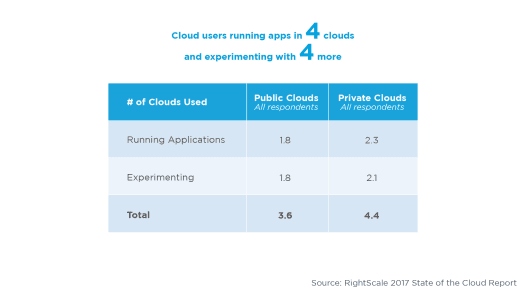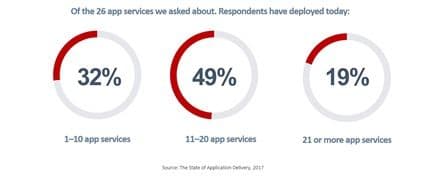There is little doubt (in my mind, at least) that the new standard operating model for enterprise organizations is based largely on cloud. I use the term “cloud” as a broad umbrella for both private (on-premises) and public (off-premises) cloud models, because all signs point to both being put to use for the foreseeable future.
In some cases, that means multiples of both, in a mixture that pits one public cloud against another against at least one (but perhaps more) private cloud options.
Regardless of how many of each model comprises an organizations’ strategy, the reality is that they’re likely to be deploying applications across multiple clouds. In other words, they’re multi-cloud. There are a number of good reasons for that, but they are not relevant for today’s discussion. Suffice to say organizations are likely employing a “multi-cloud” strategy. Nuff said.

That implies a great deal, however. David Linthicum, cloud commentator and expert extraordinaire, notes the impact on this type of strategy on DevOps initiatives in a recent article:
“1. You need a hybrid solution to devops Today’s public clouds do not provide one-stop-shopping for devops. Although they have application development management, including support for devops, it’s still a world where you’ll have to cobble together a solution from a mix of products that includes public cloud services and, yes, traditional software.”
Extending that beyond the need for Devops toolchains, it’s important to recognize that if you’re running apps in multiple clouds it’s because you’re trying to deliver them to users. Internal, external, partners. People, things, APIs. Doesn’t matter who (or what) the user is, the fact remains that you generally deploy an app with the intention of it being used to serve some business purpose, which requires that the app be delivered to whomever (or whatever) needs it.
App delivery requires services. Whether it’s simply load balancing for scale or IoT security services for your latest gizmo or gadget, there are a plethora of app services that ultimately ensure the secure delivery of apps to their intended audience. Assuming you’re going to be operating in a multi-cloud model means that the same problems as those with DevOps are going to crop up. Not all clouds deliver the same services, and native services are almost guaranteed to be incompatible with those in other clouds. You might be able to get some services from the cloud provider itself, but others remain and other sources are required to deploy them.

If we take a look at the number of app services employed by organizations today from our 2017 State of Application Delivery report, you’ll note that the bulk of organizations employ between 11 and 20 app services. That’s a lot of services, and they’re spread out across five distinct categories: availability, performance, security, identity, and mobility.
Which means you’re likely to wind up with a mix of services – cloud native and otherwise – spread across multiple-cloud providers with no way to efficiently manage them, let alone leverage their ability to provide the visibility you need to ensure the best possible application experience.
You will, as David puts so succinctly, have to “cobble together a solution from a mix of products that include public cloud services” and in this case, more traditionally delivered app services. That’s inefficient, and based on our surveys, a challenge for organizations with a multi-cloud strategy.
It’s important, then, when you’ve committed to a multi-cloud strategy to look carefully at all the various other strategies that are impacted by that. DevOps is one, and app services is certainly another. A multi-cloud app services strategy is more than just ensuring you can deploy the app services you need in each of your desired cloud environments. To realize the benefits of cloud it’s also important to ensure you can manage those services in as consistent a way possible to avoid losing visibility and policy compliance in the public clouds that comprise your new operational model.
Multi-cloud strategies may not be “the norm” quite yet, but all the signs say it will be. With a significant percentage of organizations already invested in private cloud efforts, many are now looking to public cloud to extend their capabilities and realize its benefits, too. But those benefits can be easily eaten away by inefficient solutions that aren’t able to effectively provide the consistency of management and policies required to ensure secure delivery of applications.
A multi-cloud strategy needs multi-cloud solutions, and that includes those app services so critical to delivering a secure and satisfactory application experience.
About the Author

Related Blog Posts

AppViewX + F5: Automating and orchestrating app delivery
As an F5 ADSP Select partner, AppViewX works with F5 to deliver a centralized orchestration solution to manage app services across distributed environments.

Build a quantum-safe backbone for AI with F5 and NetApp
By deploying F5 and NetApp solutions, enterprises can meet the demands of AI workloads, while preparing for a quantum future.

F5 ADSP Partner Program streamlines adoption of F5 platform
The new F5 ADSP Partner Program creates a dynamic ecosystem that drives growth and success for our partners and customers.
F5 NGINX Gateway Fabric is a certified solution for Red Hat OpenShift
F5 collaborates with Red Hat to deliver a solution that combines the high-performance app delivery of F5 NGINX with Red Hat OpenShift’s enterprise Kubernetes capabilities.
F5 Silverline Mitigates Record-Breaking DDoS Attacks
Malicious attacks are increasing in scale and complexity, threatening to overwhelm and breach the internal resources of businesses globally. Often, these attacks combine high-volume traffic with stealthy, low-and-slow, application-targeted attack techniques, powered by either automated botnets or human-driven tools.
Phishing Attacks Soar 220% During COVID-19 Peak as Cybercriminal Opportunism Intensifies
David Warburton, author of the F5 Labs 2020 Phishing and Fraud Report, describes how fraudsters are adapting to the pandemic and maps out the trends ahead in this video, with summary comments.
